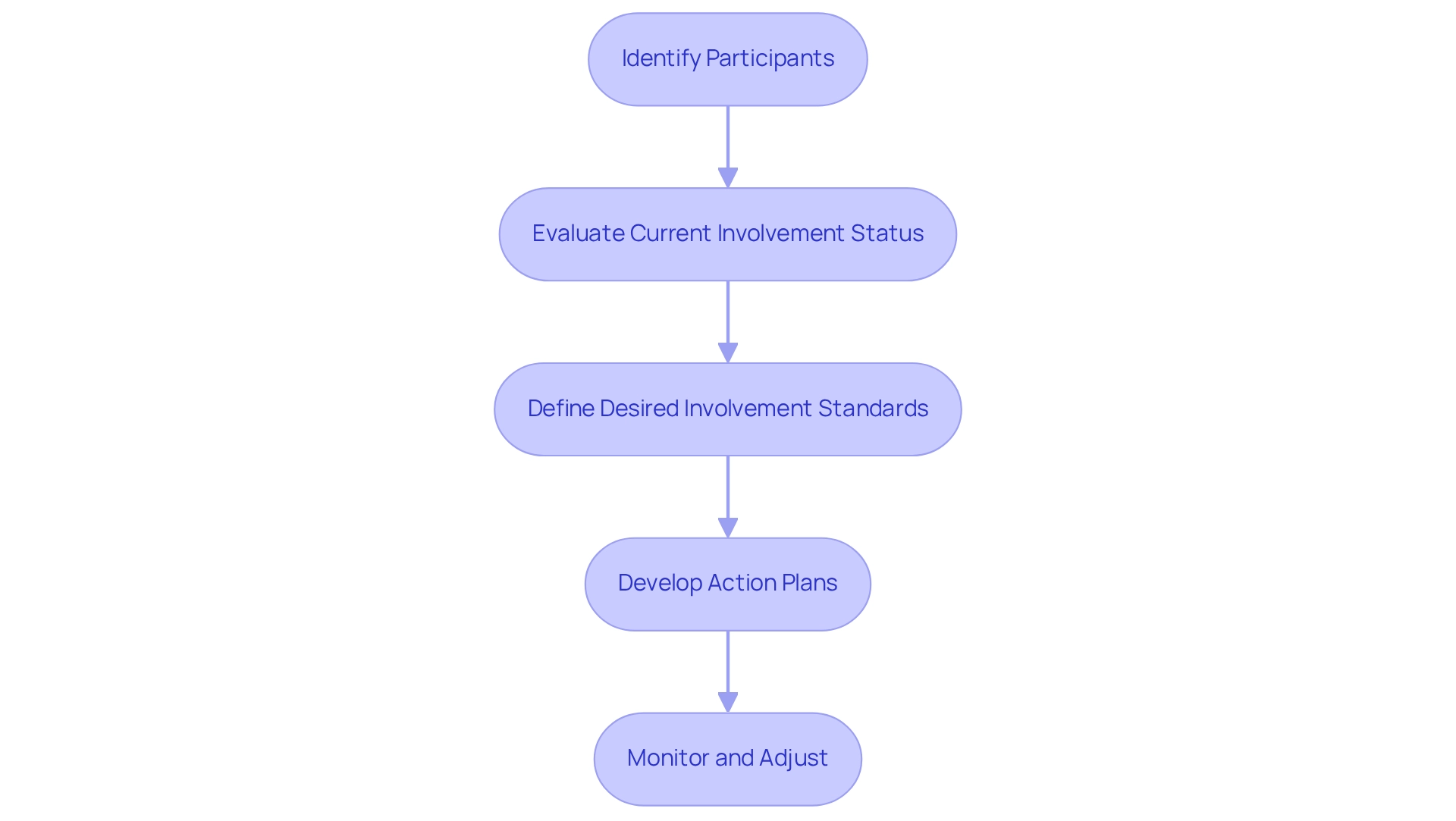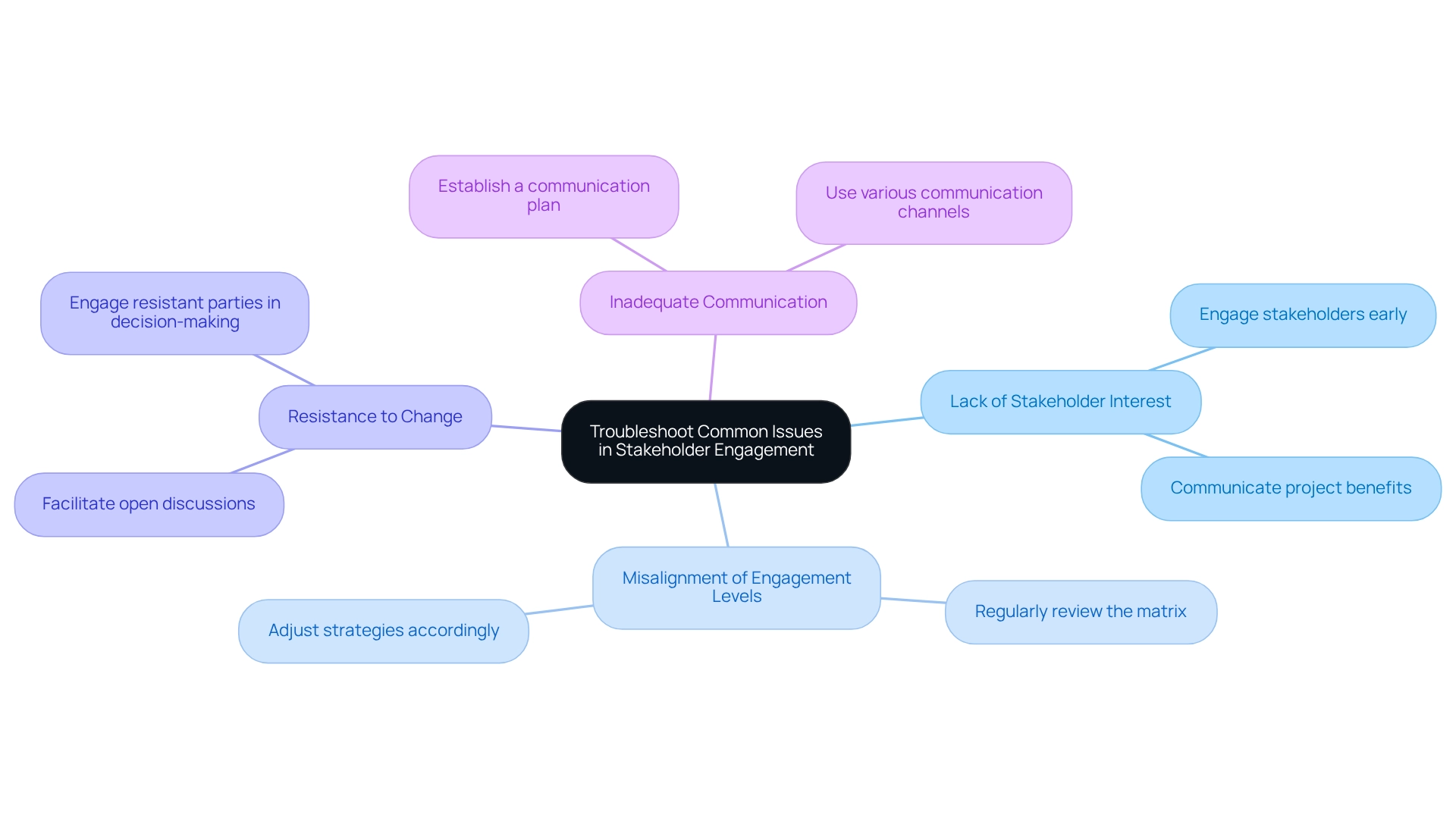Overview
The stakeholder engagement assessment matrix serves as a pivotal strategic tool in project management, meticulously evaluating and documenting the involvement levels of stakeholders. This enables the development of tailored interaction strategies that are essential for fostering effective communication. The article underscores the matrix's significance by detailing its components and implementation steps. It highlights how this tool enhances communication and alignment among stakeholders—elements that are crucial for achieving project success. Consequently, understanding and utilizing this matrix can lead to more effective stakeholder management and ultimately, better project outcomes.
Introduction
In the intricate landscape of project management, engaging stakeholders effectively is crucial for a project's success. The Stakeholder Engagement Assessment Matrix serves as a pivotal tool, enabling project managers to evaluate and strategize stakeholder involvement based on their influence and interest.
By systematically categorizing stakeholders and outlining tailored engagement plans, this matrix clarifies communication channels and aligns project objectives with stakeholder expectations.
As organizations increasingly embrace Agile methodologies, understanding and implementing this matrix becomes essential for navigating the complexities of modern project dynamics and ensuring successful outcomes.
Define the Stakeholder Engagement Assessment Matrix
The stakeholder engagement assessment matrix in project management serves as a crucial strategic tool, designed to evaluate and document both the existing and intended levels of involvement. By categorizing participants according to their influence and interest in the initiative, managers can tailor their interaction strategies effectively. The matrix typically encompasses the names of involved parties, their current involvement statuses, preferred involvement statuses, and specific actions needed to bridge any gaps. This clarity is essential; only 55% of initiative leaders indicate that business objectives are clear, underscoring the necessity for improved communication and alignment among stakeholders.
Key Components of the Matrix:
- Interested Party Identification: Catalog all individuals engaged in the initiative.
- Current Involvement Level: Assess the current participation of each stakeholder.
- Desired Involvement Level: Define the optimal level of participation for each individual.
- Action Plan: Create a roadmap to transition individuals from their current to desired participation levels.
This structured approach not only visualizes dynamics but also aids in planning effective communication strategies. Current trends reveal that 61% of top-performing organizations prioritize leadership development, emphasizing the importance of equipping teams with the skills necessary for effective engagement with stakeholders. As companies increasingly adopt Agile methodologies, the relevance of the stakeholder engagement assessment matrix in project management continues to grow, making it an indispensable element for achieving success in 2025 and beyond.

Implement the Stakeholder Engagement Assessment Matrix: A Step-by-Step Guide
To successfully execute the stakeholder engagement assessment matrix in project management, follow these steps:
- Identify Participants
Compile a comprehensive list of all individuals involved in the initiative, including team members, clients, suppliers, and any other parties affected by the initiative. - Evaluate Current Involvement Status
Assess the current involvement status of each participant. Employ surveys, interviews, or direct observations to collect insights on their participation and interest. - Define Desired Involvement Standards
Establish the ideal participation standard for each party based on their influence and interest in the initiative. This can range from minimal involvement to active participation, ensuring alignment with project goals, as outlined in the stakeholder engagement assessment matrix in project management. Include columns for participant names, current involvement levels, desired involvement levels, and corresponding action plans to facilitate clarity and tracking. - Develop Action Plans
For each participant, outline specific actions required to transition them from their current to desired involvement levels. This may involve regular updates, meetings, or customized communication strategies to enhance their participation. - Monitor and Adjust
Continuously review the matrix and adapt involvement strategies as necessary. Dynamics among involved parties can evolve, and the matrix should be updated to reflect these changes, ensuring ongoing effectiveness in managing those involved.
At SMB Turnaround, we begin each client engagement with a comprehensive business review to align key participants and better understand your business situation beyond the numbers. If you want more information or have any inquiries, let's talk! You can reach us at +1 (239) 428-9074 or visit us at 3200 Bailey Ln, Naples, FL 34105 for the latest updates.

Troubleshoot Common Issues in Stakeholder Engagement
While using the stakeholder engagement assessment matrix in project management, you may encounter several common issues that require attention. Here are some troubleshooting tips:
- Lack of Stakeholder Interest
Solution: Engage stakeholders early in the project. Communicate the project's benefits and how it aligns with their interests to foster buy-in. - Misalignment of Engagement Levels
Solution: Regularly review and update the matrix. Ensure that participants' current and desired engagement levels are accurately represented and adjust strategies accordingly. - Resistance to Change
Solution: Address concerns directly by facilitating open discussions. Offer clear details about the changes and engage resistant parties in the decision-making process to secure their support. - Inadequate Communication
Solution: Establish a communication plan that outlines how and when stakeholders will be updated. Use various channels (emails, meetings, reports) to cater to different preferences.
By proactively tackling these issues, managers can improve participant involvement and ensure smoother execution. Data suggest that successful involvement of interested parties can result in a 10% enhancement in employee retention, underscoring the significance of fostering trust and maintaining open channels of communication throughout the project lifecycle. Furthermore, classifying interested parties into groups like 'Critical Few' and 'Value at Risk' can assist in utilizing the stakeholder engagement assessment matrix in project management to create focused engagement strategies that enhance contributions from these individuals. As one expert noted, "This group has growth potential," highlighting the benefits of effective stakeholder management.

Conclusion
The Stakeholder Engagement Assessment Matrix stands as an essential instrument in project management, empowering project managers to strategically evaluate and enhance stakeholder involvement. By categorizing stakeholders according to their influence and interest, this matrix clarifies both current and desired engagement levels, while also offering a structured action plan to bridge any gaps. Such a systematic approach is crucial for fostering effective communication and aligning project objectives with stakeholder expectations, ultimately propelling project success.
Implementing the matrix entails a clear, step-by-step process that commences with identifying stakeholders and assessing their engagement levels. Through the creation of an organized framework, project managers can develop tailored action plans that cater to individual stakeholder needs, ensuring their active participation. Continuous monitoring and adjustment of the matrix keep engagement strategies relevant, adapting to the evolving dynamics within the project landscape.
Addressing prevalent challenges in stakeholder engagement—such as lack of interest, misalignment, and resistance to change—further underscores the necessity of proactive communication and customized strategies. By prioritizing stakeholder engagement, organizations can markedly enhance project outcomes and cultivate a collaborative environment that boosts overall performance. As Agile methodologies gain momentum, the relevance of the Stakeholder Engagement Assessment Matrix becomes increasingly critical, highlighting its pivotal role in navigating the complexities of contemporary project management.
Frequently Asked Questions
What is the stakeholder engagement assessment matrix?
The stakeholder engagement assessment matrix is a strategic tool in project management used to evaluate and document the existing and intended levels of stakeholder involvement by categorizing participants based on their influence and interest in the initiative.
What are the key components of the stakeholder engagement assessment matrix?
The key components include: 1. Interested Party Identification: Cataloging all individuals engaged in the initiative. 2. Current Involvement Level: Assessing the current participation of each stakeholder. 3. Desired Involvement Level: Defining the optimal level of participation for each individual. 4. Action Plan: Creating a roadmap to transition individuals from their current to desired participation levels.
Why is the stakeholder engagement assessment matrix important?
It is important because it provides clarity on stakeholder dynamics, aids in planning effective communication strategies, and helps ensure that business objectives are clearly understood among stakeholders, addressing the fact that only 55% of initiative leaders report clarity in their objectives.
How does the stakeholder engagement assessment matrix support Agile methodologies?
As companies increasingly adopt Agile methodologies, the stakeholder engagement assessment matrix becomes essential for effective stakeholder engagement, which is crucial for achieving project success in the evolving landscape of project management.
What trends are influencing the use of the stakeholder engagement assessment matrix?
Current trends indicate that 61% of top-performing organizations prioritize leadership development, highlighting the need for equipping teams with skills necessary for effective engagement with stakeholders, which reinforces the relevance of the matrix.




